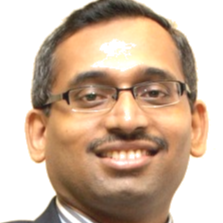
Rajasvaran Logeswaran
Work place: Asia Pacific University of Technology & Innovation (APU), Technology Park Malaysia, Bukit Jalil, 57000 Kuala Lumpur, Malaysia
E-mail: logeswaran@apu.edu.my
Website:
Research Interests: Human-Computer Interaction, Computer systems and computational processes, Artificial Intelligence, Computer Architecture and Organization, Computer Networks, Mathematics of Computing
Biography
Rajasvaran Logeswaran studied his B.Eng (Hons) Computing at Imperial College London, United Kingdom, and completed his M.Eng.Sc. as well as Ph.D. at Multimedia University, Malaysia. He is a Novell Certified Linux Professional, and a certified IC Digital Citizen and trainer. His areas of interests include multimedia data processing, data compression, neural networks, natural user interfaces and big data, with over a hundred publications in books, peer-reviewed journals and international conference proceedings. He has been a recipient of several scholarships, including Telekom Malaysia, the JCS 75th Anniversary Scholar, the Brain Gain Malaysia international fellowship & post-doctoral programme, as well as the Brain Korea21 post-doctoral grant. A Senior Member of the IEEE, he is the Secretary of the IEEE Signal Processing Society Malaysia chapter and a reviewer of numerous journals and conferences.
Author Articles
Usability Evaluation Criteria for Internet of Things
By Michael Onuoha Thomas Beverly Amunga Onyimbo Rajasvaran Logeswaran
DOI: https://doi.org/10.5815/ijitcs.2016.12.02, Pub. Date: 8 Dec. 2016
The field of usability, user experience (UX) design and human-computer interaction (HCI) arose in the realm of desktop computers and applications. The current experience in computing has radically evolved into ubiquitous computing over the preceding years. Interactions these days take place on different devices: mobile phones, e-readers and smart TVs, amid numerous smart devices. The use of one service across multiple devices is, at present, common with different form factors. Academic researchers are still trying to figure out the best design techniques for new devices and experiences. The Internet of Things (IoT) is growing, with an ever wider range of daily objects acquiring connectivity, sensing ability and increased computing power. Designing for IoT raises a lot of challenges; the obvious difference being the much wider variety of device form factors. IoT is still a technically driven field, thus the usability of many of IoT products is, in some way, of the level anticipated of mature consumer products. This study focuses on proposing a usability evaluation criterion for the generic IoT architecture and essential technological components.
[...] Read more.Other Articles
Subscribe to receive issue release notifications and newsletters from MECS Press journals